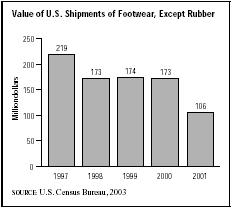SIC 3131
BOOT AND SHOE CUT STOCK AND FINDINGS
Establishments that fall under this category are primarily engaged in manufacturing leather soles, inner soles, and other boot and shoe cut stock and findings. The industry also includes finished wood heels. Establishments primarily engaged in manufacturing heels, soiling strips, and soles made of rubber, composition, plastics, and fiber are classified in the major group for rubber and miscellaneous plastics products.
NAICS Code(s)
321999 (All Other Miscellaneous Wood Product Manufacturing)
339993 (Fasteners, Button, Needle, and Pin Manufacturing)
316999 (All Other Leather Good Manufacturing)
In the early 2000s, the boot and shoe cut stock findings segment continued to suffer from the growing penetration of relatively low-cost imported footwear into the United States. According to footwear industry statistics, in 1966 the United States market for nonrubber footwear totaled 735 million pairs, and 641 million pairs were made in America. By 1996, the market had grown to 1,218 million pairs, but the U.S. produced only 143 million pairs. The import/export imbalance was even more telling—1,098 million pairs were imported in 1996, while only 24 million were exported. As a result, U.S. manufacturers began to shift operations overseas to take advantages of lower operating costs in countries like China. In fact, by 2003, China was exporting more than 1.3 billion pairs of shoes into the United States annually.
In this environment, many of the footwear plants that did remain in the United States were forced to close, and plant openings had slowed to a trickle by the late 1990s. Pricing was also under intense pressure due to competition from imported shoes. In the labor-intensive footwear industry, U.S. makers simply could not compete with manufacturers overseas whose wage rates were far below U.S. levels. When nonrubber footwear penetration levels reached 98 percent in the early 2000s, the American Apparel and Footwear Association, which had once been vehemently opposed to the growing levels of imports,

began calling for the elimination of tariffs on nonrubber footwear imports. As stated in a June 2002 issue of Footwear News , "In a dramatic reversal that reflects the changed character of the domestic footwear business, the American Apparel & Footwear Association has shifted its international footwear trade policy to vigorously support free trade."
The drop in domestically produced footwear, of course, had depressed the business of companies that supply shoe manufacturers. Besides the dramatic increase in shoe imports, leather sole makers also had to contend with a shift by consumers to more casual footwear and the rising cost of leather. While there remained a market for the fine leather shoe, many Americans were no longer dressing up for work and did not require several pairs of dress shoes.
During the recession of the early 1990s, the repair trade picked up somewhat, as consumers have traditionally mended old shoes when they did not have the money to buy new ones. Some manufacturers thought sales were less robust than in previous recessions, however, because of the loss of white-collar jobs. There was also concern about longer term trends in the repair market. During the World War II, the number of repair shops totaled nearly 70,000; by the late 1990s, there were fewer than 12,000. Shoe repair employees in 2001 totaled a mere 3,400, according to the U.S. Department of Labor. One estimate showed that only 8 to 10 percent of consumers made use of shoe repair shops, and the average customer was 45 years old. The availability of inexpensive imported footwear also could encourage people to simply buy new shoes rather than repair old ones.
The early 2000s did not show any encouraging signs for the industry's success. The value of U.S. shipments for nonrubber footwear declined nearly each year between 1997 and 2001. The most dramatic decline took place between 2000 and 2001, when shipments fell from $173 million to $106 million.
Further Reading
Ellis, Kristi. "AAFA Joins the Call for Free Trade." Footwear News, 24 June 2002.
——. "U.S. Footwear Imports Saw Improvement in 2003." Footwear News, 12 January 2004.
U.S. Census Bureau. "Statistics for Industry Groups and Industries: 2000." February 2002. Available from http://www.census.gov/prod/2002pubs/m00as-1.pdf .
——. "Value of Shipments for Product Classes: 2001 and Earlier Years." December 2002. Available from http://www.census.gov/prod/2003pubs/m01as-2.pdf .
U.S. Department of Labor. 2001 National Industry-Specific Occupational Employment and Wage Estimates: SIC 725 - Shoe Repair Shops and Shoeshine Parlors. Washington, DC: Bureau of Labor Statistics, 2002. Available from http://www.bls.gov/oes/2001/oesi3_725.htm .
Comment about this article, ask questions, or add new information about this topic: